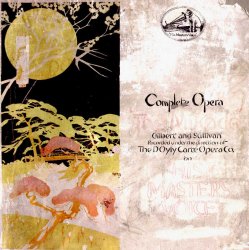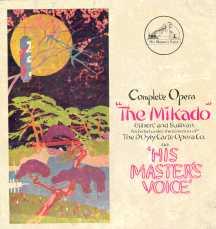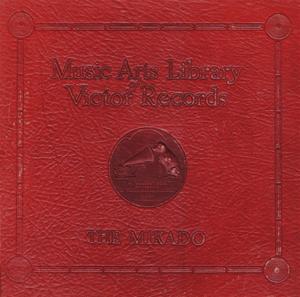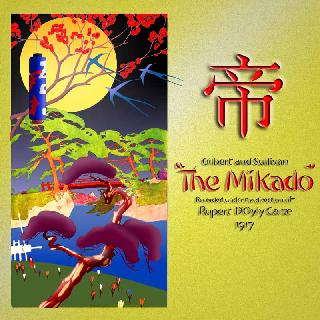The 1917 HMV Mikado
|
|
Chorus and Mayfair Orchestra
Conductors: George W. Byng / Arthur Wood
Recorded in London,
30 July–3 August 1917
 HMV Album Cover |
After Odeon's 1907 Mikado failed to sell well, the record companies evidently decided to stop making complete sets for a while. Compounding the problem was D'Oyly Carte's extended absence from central London, which presumably dampened the interest among those most likely to be buying records. However, in March, 1917, HMV renewed its interest and secured the artistic guidance of Rupert D'Oyly Carte's musical director and stage manager. This was enough for the phrase "recorded under the direction of Mr. Rupert D'Oyly Carte" to appear on records for the first time.
Under the covers, however, the recording had hardly anything to do with D'Oyly Carte. As had been customary from the earliest days of the gramophone, the opera was recorded by stock recording artists whose voices were known to record well. There was little consistency in casting, and indeed it would appear that roles were assigned based only on who showed up on a particular day; surely, one cannot imagine that such a patchwork quilt of singing assignments would have been planned.
 "78s 2 CD" GS06 |
This was the first complete set to include George Baker. (He had already recorded at least one G&S single—see Gilbert and Sullivan: The Early Records). Baker never appeared with D'Oyly Carte, but he had an excellent intuitive feel for the Savoy Operas. Even after HMV started casting authentic artists in most of the roles, a place was found for Baker on nearly every 78rpm set made.
In the late 1950s, twenty-five years after his last G&S recordings with D'Oyly Carte, Sir Malcolm Sargent brought Baker out of retirement and cast him as the comic lead in several of the "Glyndebourne" recordings. Even in his late-seventies he gave credible performances, but certainly not as good as his 78's, which were made in his prime.
The allocation of the split roles is as follows:
 Victor used this album design when it issued this set in March, 1925. Victor later used the same album design for its issue of the 1926 recording, before replacing the design in 1931. |
- Nanki-Poo
- Pike sings "Brightly dawns";
Harrison sings the rest. - Pooh-Bah
- Harrison sings "See how the fates";
Radford sings the rest. - Pish-Tush
- Baker sings "Our great Mikado" and "So please you sir"; Pike sings "I am so proud"; Radford sings "Brightly dawns."
- Yum-Yum
- Jones sings "Brightly dawns";
Essex sings the rest. - Pitti-Sing
- Oppenshaw sings "Braid the raven hair";
Jones sings "See how the fates";
Thornton sings the rest. - Peep-Bo
- Oppenshaw sings "Three little maids"; Jones sings "So please you sir."
- Conductor
- Wood conducts "As someday it may happen"; Byng conducts the rest.
Compared with the 1907 Odeon recording (which has the benefit of Walter Passmore's Ko-Ko) and the 1927 recording (which has D'Oyly Carte singers in nearly all the roles) this recording may seem comparatively unimportant, although George Baker's Ko-Ko has been highly praised. You can listen for yourself, if you buy the CD re-issue on Chris Webster's Sounds on CD label.
| Date | Label | Format | Number | Comments |
|---|---|---|---|---|
| 1918 | HMV | 78rpm | D 2/12 | |
| Pre-1924 | Victor (Canada) | 78rpm | 55181/91 | See related article |
| Mar. 1925 | Victor (U.S.) | |||
| 198-? | Sir Arthur Sullivan Society | Cassette | unnumbered | |
| 1999 | Sounds on CD | CD | VGS 210 | |
| 1999 | 78s 2 CD | CD | GS06 | |
| 1999 | Opera Classics | CD-ROM | AE205 | CD-ROM titled "From Which We Came," including numerous early recordings of opera. The G&S content (which is only a fraction of what's on the disc) includes the HMV acoustical recordings of The Mikado, H.M.S Pinafore, Princess Ida, and Ruddigore. Note that this CD can be played only on a computer, not on a conventional audio player. |
| Side Nbr | Matrix Number | Contents | Rec. Date |
|---|---|---|---|
| 1 | HO2815af |
|
15 Aug 17 |
| 2 | HO2817af |
|
15 Aug 17 |
| 3 | HO2779af |
|
30 Jul 17 |
| 4 | HO2772af HO2773af |
|
30 Jul 17 |
| 5 | HO2812af |
|
15 Aug 17 |
| 6 | HO2809af |
|
15 Aug 17 |
| 7 | HO2790af |
|
2 Aug 17 |
| 8 | HO2775af |
|
30 Jul 17 |
| 9 | HO2792af |
|
2 Aug 17 |
| 10 | HO2814af |
|
15 Aug 17 |
| 11 | HO2807af HO2808af |
|
15 Aug 17 |
| 12 | HO2769af |
|
30 Jul 17 |
| 13 | HO2771af |
|
30 Jul 17 |
| 14 | HO2777af |
|
30 Jul 17 |
| 15 | HO2781 |
|
30 Jul 17 |
| 16 | HO2915af |
|
16 Oct 17 |
| 17 | HO2798af |
|
15 Aug 17 |
| 18 | HO2800af |
|
15 Aug 17 |
| 19 | HO2802af |
|
15 Aug 17 |
| 20 | HO2803af HO2804af |
|
15 Aug 17 |
| 21 | HO2806af |
|
15 Aug 17 |
| 22 | HO2782af |
|
30 Jul 17 |
Notes:
- Francis does not report that any alternate takes were issued with this set, but Chris Webster has confirmed them for sides 4, 11, and 20.
- Francis says that Arthur Wood conducts only s. 7, "As someday it may happen". However, s. 9 was also recorded the same day, and it seems implausible that Wood was brought in to conduct just one side. Other sides (unpublished) could, of course, have been recorded that day.
- Francis says that s. 16 was recorded on 2 August 1917. However, the matrix number is much higher than any other in the set, so if Francis is right, we must accept the unlikely premise that a matrix number was used out of order. More likely, Francis's date is inaccurate.
- Sides 15 & 21 were included on Arabesque's LP reissue of the 1931 Ruddigore.
Result | Matrix Number | Selection |
|---|---|---|
| Session One, 30 July 1917 | ||
| Rejected | HO2766af HO2767af |
|
| Issued s. 12 | HO2768af HO2769af |
|
| Issued s. 13 | HO2770af HO2771af |
|
| Issued s. 4 | HO2772af HO2773af |
|
| Issued s. 8 | HO2774af HO2775af |
|
| Issued s. 14 | HO2776af HO2777af |
|
| Issued s. 3 | HO2778af HO2779af |
|
| Issued s. 15 | HO2780af HO2781af |
|
| Issued s. 22 | HO2782af HO2783af HO2784af |
|
| Session Two, 2 Aug 1917 | ||
| Issued s. 7 | HO2789af HO2790af |
|
| Issued s. 9 | HO2791af HO2792af |
|
| Session Three, 15 Aug 1917 | ||
| Issued s. 17 | HO2796af HO2797af HO2798af |
|
| Issued s. 18 | HO2799af HO2800af |
|
| Issued s. 19 | HO2801af HO2802af |
|
| Issued s. 20 | HO2803af HO2804af |
|
| Issued s. 21 | HO2805af HO2806af |
|
| Issued s. 11 | HO2807af HO2808af |
|
| Issued s. 6 | HO2809af HO2810af |
|
| Issued s. 5 | HO2811af HO2812af |
|
| Issued s. 10 | HO2813af HO2814af |
|
| Issued s. 1 | HO2815af HO2816af |
|
| Issued s. 2 | HO2817af HO2818af |
|
| Session Four, 16 Oct 1917 | ||
| Rejected | HO2914af |
|
| Issued s. 16 | HO2915af HO2916af |
|
Notes:
- The table above lists the order in which the sides were recorded. Where there were multiple attempts at a side on the same day, none of which are known to have been issued, the entire row is shown in italics, and the word "Rejected" appears in the "Result" column.
- Where there were multiple attempts at a side on the same day, at least one of which was issued, the word "Issued" and the side number appear in the "Result" column. For takes not known to have been issued, the matrix number is shown in italics.
- Details of unissued takes were supplied by Chris Webster, who had access to copies of the artist sheets made during the sessions. The roles sung are indicated in brackets, as it would otherwise be ambiguous in some cases.

